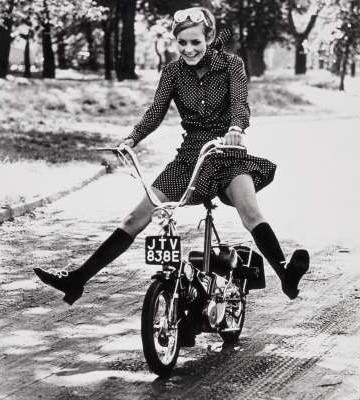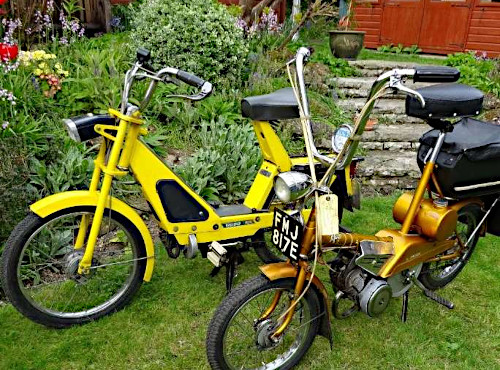The Flash and the Wisp... Straight from the 1960s—well not quite, since it is a Solex 6000, the later version of the Flash, that we are looking at here along with the Raleigh Wisp.

Back in the 1960s, Twiggy demonstrating
what fun can be had on a Raleigh Wisp.
Both the Solex 6000 and Raleigh Wisp were the final new products of two famous moped manufacturers, and represent their last attempts at meeting the expectations of the swinging sixties. Both were small wheeled and radical in their design.
The Solex concept dated back to post war France, provided cheap transport for the masses being a motorised bicycle. Its front wheel was driven by a carborundum roller. It was developed from the original 45cc motor, producing 4bhp. The final 3800 version had a more powerful engine, centrifugal clutch and pressed steel frame. But by the 1970s the design looked increasingly antique in comparison with the trendy new mopeds flooding the market. So, the Flash/6000 was introduced, a very different bike with more power, shaft drive to the rear wheel, disk rear brake, and a marketing campaign which featured young trendy riders with the catch line ‘We should have called it the Solex GT’.
The Raleigh Wisp was the final design of the Mobylette engined mopeds made in the UK. They were the successors to the original 1958 RM1/RM2. They had a a Sturmey–Archer engine powering a beefed up bicycle frame. It was introduced in 1967, intended to benefit from the small wheel bicycle craze that Raleigh and Moulton had created. So, with a completely new frame, but well tried French built engine, it was launched by the model Twiggy to the youth market. Excessively low gearing for the initial production runs dampened enthusiasm for the machine, but this was later corrected with a smaller rear wheel sprocket.
But both these designs had a short production life. The Solex Flash/6000 suffered from weaknesses in the transmission. If you dropped the rear wheel on the ground with the clutch engaged and the engine running fast it was likely that a cast in drive key would break. This lead to a complete failure. Solex reportedly paid out huge warranty claims.
Ironicaly, it was the previous conventional design, the 3800, that was still in production when the factory finally closed in 1988. The original Flash version was replaced by the 6000 in 1972, but it was a styling change rather than a resolution to the fundamental weaknesses. By 1977 the 6000 was no more. None was sold new in the UK and preserved (working) examples are rarely seen here.
In the face of overwhelming competition in the UK, Raleigh ended all moped production in 1969, so the Wisp had a production run of only two years. Although there were some frame weaknesses, they remain popular collector’s items in the UK and some spares are available. It is just the scary road-holding resulting from the small 16" wheels that can be off putting.
So they both were valiant efforts to keep up with the times, but in their different ways they failed. The photo shows our examples of these unusual bikes.

Sandy's Solex 6000 and Raleigh Wisp
First published in The MAC, No.82. June 2024
